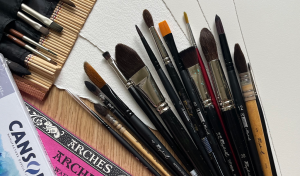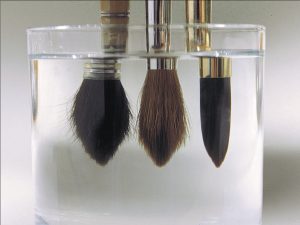Watercolour is a beautiful and versatile medium that allows artists to create stunning works of art. Choosing the right brushes is one of the key elements in creating a watercolour painting. The type and quality of brushes you use can significantly impact your ability to achieve the desired effects and textures in your artwork. In this blog post, we’ll explore the different types of brushes best suited to watercolour painting, and provide guidance on choosing the right brushes for your artistic needs.
Types of watercolour brushes
There are different types of brushes designed specifically for watercolour painting. Each type of brush has a different purpose, and understanding their characteristics is important to achieve the desired results in your artwork:
- Round brushes: Round brushes are the most versatile and commonly used brushes for watercolour painting. They are the most common and most commonly used paint brushes and are ideal for detail, line work and precision work.
- Flat brushes: Flat brushes are rectangular in shape and have a flat, wide bristled surface. These brushes are perfect for covering large surfaces, creating washes and achieving broad lines.
- Filbert brushes: Filbert brushes offer a balance between the characteristics of rounded and flat brushes, making them suitable for both fine detailing and broad strokes.
- Liner brushes: Liner brushes, also called script brushes, have long, thin hairs that hold a lot of water and paint. They are ideal for creating long, flowing lines and fine details.
- Fan brushes: Fan brushes have semi-circularly arranged hairs. They are ideal for creating textures, blending colours and, for example, creating leaf effects.
- Mop brushes: Mop brushes have soft, absorbent hairs and are round or oval in shape. They are ideal for creating soft edges, blending and applying colour washes.
Brush materials
The material of the brushes also plays an important role in watercolour painting. The most common bristle materials for watercolour brushes are:
- Sable or synthetic sable: Sable brushes are known for their excellent water absorbency and ability to create fine detail. Synthetic sable brushes offer similar properties but are less expensive and more animal-friendly.
- Squirrel or synthetic squirrel: Squirrel hair brushes are incredibly soft and absorbent, making them ideal for applying a wash of paint and achieving an even coat. Squirrel hair brushes are also available in synthetic imitation brushes.
- Kolinsky: Kolinsky brushes are considered to be the highest quality natural brushes. They have a fine tip, hold water and pigment exceptionally well and are preferred by professional watercolourists. An interesting fact is that the Kolinsky hair is obtained from the tail of the kolinsky (Mustela sibirica), which is more like a weasel than a sable.
- Synthetic: They are well suited to beginners and those looking for cruelty-free options. Synthetic brushes are also available in a variety of features. Softer synthetic brushes are more suitable for watercolour painting.
Brush sizes
Watercolour brushes, like all paintbrushes, come in different sizes, usually identified by a number printed on the handle. The size number generally refers to the diameter of the brush bundle at its widest point, but it is important to remember that each brush manufacturer labels their brush sizes differently. Smaller brushes (e.g., 0, 1, 2) are good for fine detail, while larger brushes (e.g., 10, 12, 14) are better for covering larger areas.
Brush care and maintenance
Proper care of watercolour brushes is essential to ensure their longevity and performance. Here are some tips for brush maintenance:
- Clean brushes thoroughly after each use to remove all paint residue. Use a gentle brush cleaner or mild soap and warm water.
- Avoid prolonged immersion in water, as this may damage the hairs.
- Preferably dry the brushes with the hair facing downwards, or horizontally. This way, the water drains out of the brush and does not damage the brush handle or the ferrule.
- When dry, hold the brushes with the hair upwards to maintain their shape.
- Avoid excessive pressure when using the brushes as this can damage the brush hair.
Summary
Choosing the right brushes is an important step in mastering the art of watercolour painting. Knowing the different types of brushes, their materials and sizes will enable you to create the effects and details you want in your work. Remember that practice and experimentation are the keys to finding brushes that best suit your unique style and preferences. So don’t be afraid to explore different options and techniques as you embark on your watercolour brushes journey.



